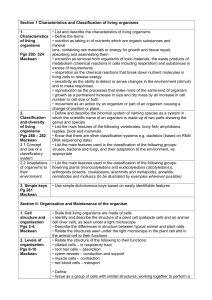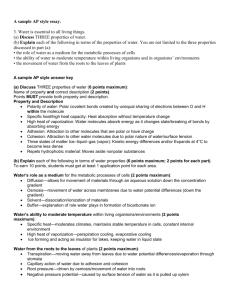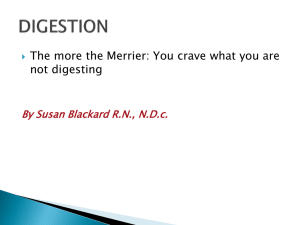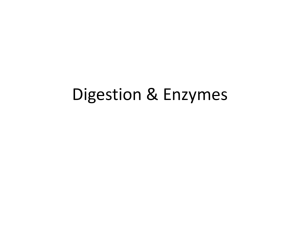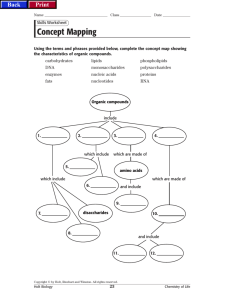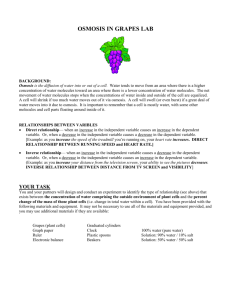Year 9 IGCSE Biology Revision Checklist
advertisement
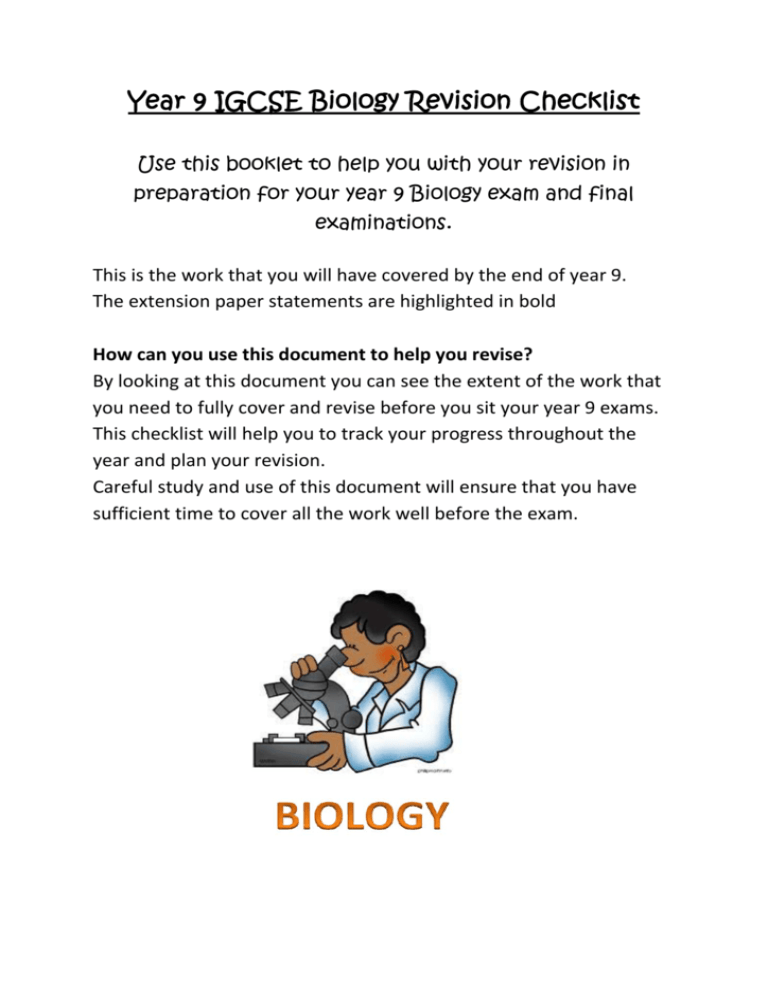
Year 9 IGCSE Biology Revision Checklist Use this booklet to help you with your revision in preparation for your year 9 Biology exam and final examinations. This is the work that you will have covered by the end of year 9. The extension paper statements are highlighted in bold How can you use this document to help you revise? By looking at this document you can see the extent of the work that you need to fully cover and revise before you sit your year 9 exams. This checklist will help you to track your progress throughout the year and plan your revision. Careful study and use of this document will ensure that you have sufficient time to cover all the work well before the exam. 1. Characteristics of living organisms Describe the characteristics of living organisms by defining terms: movement as an action by an organism or part of an organism causing a change of position or place – respiration as the chemical reactions in cells that break down nutrient molecules and release energy for metabolism – sensitivity as the ability to detect or sense stimuli in the internal or external environment and to make appropriate responses – growth as a permanent increase in size and dry mass by an increase in cell number or cell size or both – excretion as removal from organisms of the waste products of metabolism (chemical reactions in cells including respiration), toxic materials, and substances in excess of requirements – nutrition as taking in of materials for energy, growth and development; plants require light, carbon dioxide, water and ions; animals need organic compounds and ions and usually need water Concept and use of a classification system • State that organisms can be classified into groups by the features that they share • Define species as a group of organisms that can reproduce to produce fertile offspring • Define and describe the binomial system of naming species as an internationally agreed system in which the scientific name of an organism is made up of two parts showing the genus and species Explain that classification systems aim to reflect evolutionary relationships • Explain that classification is traditionally based on studies of morphology and anatomy • Explain that the sequences of bases in DNA and of amino acids in proteins are used as a more accurate means of classification • Explain that organisms which share a more recent ancestor (are more closely related) have base sequences in DNA that are more similar than those that share a distant ancestor Features of organisms • List the features in the cells of all living organisms, limited to cytoplasm, cell membrane and DNA as genetic material • List the main features used to place animals and plants into the appropriate kingdoms • List the main features used to place organisms into groups within the animal kingdom, limited to the main groups of vertebrates: mammals, birds, reptiles, amphibians, fish and the main groups of arthropods: myriapods, insects, arachnids, crustaceans List the features in the cells of all living organisms, limited to ribosomes for protein synthesis and enzymes involved in respiration • List the main features used to place all organisms into one of the five kingdoms: Animal, Plant, Fungus, Prokaryote, Protoctist • List the main features used to place organisms into groups within the plant kingdom, limited to ferns and flowering plants (dicotyledons and monocotyledons) • List the features of viruses, limited to protein coat and genetic material Dichotomous keys • Construct and use simple dichotomous keys based on easily identifiable features 2. Organisation of the organism Cell structure and organisation Describe and compare the structure of a plant cell with an animal cell, as seen under a light microscope, limited to cell wall, nucleus, cytoplasm, chloroplasts, vacuoles and location of the cell membrane • State the functions of the structures seen under the light microscope in the plant cell and in the animal cell • State that the cytoplasm of all cells contains structures, limited to ribosomes on rough endoplasmic reticulum and vesicles • State that almost all cells, except prokaryotes, have mitochondria and rough endoplasmic reticulum • Identify mitochondria and rough endoplasmic reticulum in diagrams and images of cells • State that aerobic respiration occurs in mitochondria • State that cells with high rates of metabolism require large numbers of mitochondria to provide sufficient energy Levels of organisation Relate the structure of the following to their functions: – ciliated cells, root hair cells, xylem vessels, palisade mesophyll cells, nerve cells, red blood cells, sperm and egg cells • Define tissue, organ, organ system and state examples • Identify the different levels of organisation in drawings, diagrams and images of familiar material • Identify the different levels of organisation in drawings, diagrams and images of unfamiliar material Size of specimens Calculate magnification and size of biological specimens using millimetres as units • Calculate magnification and size of biological specimens using millimetres and micrometres as units 3. Movement in and out of cells Diffusion Define diffusion as the net movement of particles from a region of their higher concentration to a region of their lower concentration down a concentration gradient, as a result of their random movement • Describe the importance of diffusion of gases and solutes • State that substances move into and out of cells by diffusion through the cell membrane • State that the energy for diffusion comes from the kinetic energy of random movement of molecules and ions • Investigate the factors that influence diffusion, limited to surface area, temperature, concentration gradients and distance Osmosis State that water diffuses through partially permeable membranes by osmosis • State that water moves in and out of cells by osmosis through the cell membrane • Investigate and describe the effects on plant tissues of immersing them in solutions of different concentrations • State that plants are supported by the pressure of water inside the cells pressing outwards on the cell wall • Define osmosis as the net movement of water molecules from a region of higher water potential (dilute solution) to a region of lower water potential (concentrated solution), through a partially permeable membrane • Explain the effects on plant tissues of immersing them in solutions of different concentrations by using the terms turgid, turgor pressure, plasmolysis and flaccid • Explain the importance of water potential and osmosis in the uptake of water by plants • Explain the importance of water potential and osmosis on animal cells and tissues • Explain how plants are supported by the turgor pressure within cells, in terms of water pressure acting against an inelastic cell wall Active transport Define active transport as the movement of particles through a cell membrane from a region of lower concentration to a region of higher concentration using energy from respiration • Discuss the importance of active transport as a process for movement across membranes: e.g. ion uptake by root hairs and uptake of glucose by epithelial cells of villi and kidney tubules • Explain how protein molecules move particles across a membrane during active transport 4. Biological Molecules List the chemical elements that make up: carbohydrates, fats, proteins • State that large molecules are made from smaller molecules, limited to: starch and glycogen from glucose, cellulose from glucose, proteins from amino acids, fats and oils from fatty acids and glycerol • Describe the use of: – iodine solution to test for starch – Benedict’s solution to test for reducing sugars – biuret test for proteins – ethanol emulsion test for fats and oils – DCPIP test for vitamin C • Explain that different sequences of amino acids give different shapes to protein molecules • Relate the shape and structure of protein molecules to their function, limited to the active site of enzymes and the binding site of antibodies State that water is important as a solvent • Describe the roles of water as a solvent in organisms with respect to digestion, excretion and transport 7. Human Nutrition Diet • State what is meant by the term balanced diet for humans • Explain how age, gender and activity affect the dietary needs of humans including during pregnancy and whilst breast-feeding • Describe the effects of malnutrition in relation to starvation, constipation, coronary heart disease, obesity and scurvy • List the principal sources of, and describe the dietary importance of: carbohydrates, fats, proteins, vitamins, C and D, mineral salts, limited to calcium and iron, fibre (roughage), water • Explain the causes and effects of vitamin D and iron deficiencies and protein-energy malnutrition, e.g. kwashiorkor and marasmus Mechanical digestion • Identify the types of human teeth (incisors, canines, premolars and molars) • Describe the structure of human teeth, limited to enamel, dentine, pulp, nerves and cement, as well as the gums • Describe the functions of the types of human teeth in mechanical digestion of food • State the causes of dental decay in terms of a coating of bacteria and food on teeth, the bacteria respiring sugars in the food, producing acid which dissolves the enamel and dentine • Describe the proper care of teeth in terms of diet and regular brushing Alimentary canal • Define ingestion as the taking of substances, e.g. food and drink, into the body through the mouth • Define mechanical digestion as the breakdown of food into smaller pieces without chemical change to the food molecules • Define chemical digestion as the breakdown of large, insoluble molecules into small, soluble molecules • Define absorption as the movement of small food molecules and ions through the wall of the intestine into the blood • Define assimilation as the movement of digested food molecules into the cells of the body where they are used, becoming part of the cells • Define egestion as the passing out of food that has not been digested or absorbed, as faeces, through the anus • Describe diarrhoea as the loss of watery faeces • Outline the treatment of diarrhoea using oral rehydration therapy • Describe cholera as a disease caused by a bacterium • Identify the main regions of the alimentary canal and associated organs, limited to mouth, salivary glands, oesophagus, stomach, small intestine (duodenum and ileum), pancreas, liver, gall bladder and large intestine (colon, rectum, anus) • Describe the functions of the regions of the alimentary canal listed above, in relation to ingestion, digestion, absorption, assimilation and egestion of food • Explain that the cholera bacterium produces a toxin that causes secretion of chloride ions into the small intestine, causing osmotic movement of water into the gut, causing diarrhoea, dehydration and loss of salts from blood Chemical digestion • State the significance of chemical digestion in the alimentary canal in producing small, soluble molecules that can be absorbed • State the functions of enzymes as follows: amylase breaks down starch to simpler sugars, protease breaks down protein to amino acids, lipase breaks down fats to fatty acids and glycerol • State where, in the alimentary canal, amylase, protease and lipase are secreted • State the functions of the hydrochloric acid in gastric juice, limited to killing bacteria in food and giving an acid pH for enzymes • Describe the digestion of starch in the alimentary canal: – amylase is secreted into the alimentary canal and breaks down starch to maltose – maltose is broken down by maltase to glucose on the membranes of the epithelium lining the small intestine • Describe pepsin and trypsin as two protease enzymes that function in different parts of the alimentary canal: – pepsin in the stomach and trypsin in the small intestine • Explain the functions of the hydrochloric acid in gastric juice, limited to the low pH: denaturing enzymes in harmful microorganisms in food and giving the optimum pH for pepsin activity • Outline the role of bile in neutralising the acidic mixture of food and gastric juices entering the duodenum from the stomach, to provide a suitable pH for enzyme action • Outline the role of bile in emulsifying fats to increase the surface area for the chemical digestion of fat to fatty acids and glycerol by lipase Absorption • Identify the small intestine as the region for the absorption of digested food • State that water is absorbed in both the small intestine and the colon, but that most absorption of water happens in the small intestine • Explain the significance of villi and microvilli in increasing the internal surface area of the small intestine • Describe the structure of a villus • Describe the roles of capillaries and lacteals in villi 5. Enzymes Define the term catalyst as a substance that increases the rate of a chemical reaction and is not changed by the reaction Define enzymes as proteins that function as biological catalysts •Describe why enzymes are important in all living organisms in terms of reaction speed necessary to sustain life on enzyme activity. Explain enzyme action with reference to the active site, enzyme-substrate complex, substrate and product • Describe and explain the specificity of enzymes in terms of the complementary shape and fit of the active site with the substrate • Describe and explain the effect of changes in temperature on enzyme activity in terms of kinetic energy, shape and fit, frequency of effective collisions and denaturation • Describe and explain the effect of changes in pH on enzyme activity in terms of shape and fit and denaturation
